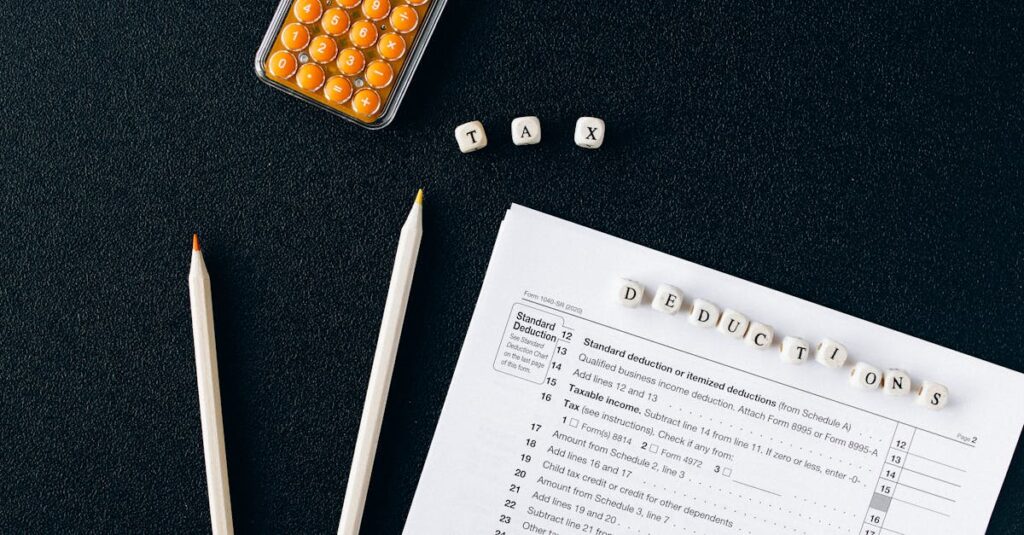How to Save on Income Tax: Top Deductions and Exemptions Explained
Paying income tax is a fundamental responsibility for every earning citizen and business in India. However, understanding the tax laws allows you to strategically plan your finances and significantly reduce your tax burden legally. Knowing the available avenues is the first step to smarter financial management. If you want to save on income tax, understanding the rules is key.
This guide is specifically designed for salaried individuals and small business owners in India. We will explore the key income tax deductions India and tax exemptions explained India available under the Income Tax Act, helping you make informed decisions and optimize your tax savings, primarily focusing on the options available under the Old Tax Regime.
Understanding the Basics: Old vs. New Tax Regime
Before diving into specific deductions, it’s crucial to understand how your taxable income is calculated and the choice you have between two tax regimes.
What is Taxable Income?
Your Gross Total Income (GTI) includes income from all sources like salary, business profits, house property, capital gains, and other sources. Taxable Income is what remains after you subtract eligible deductions from your GTI. Your final income tax liability is calculated based on this taxable income according to the applicable tax slabs.
The Critical Choice: Old vs. New Tax Regime
India offers taxpayers a choice between two tax calculation methods:
- Old Tax Regime: This regime has slightly higher tax slab rates but allows you to claim numerous deductions and exemptions (like those under Section 80C, 80D, HRA, etc.).
- New Tax Regime (Section 115BAC): This regime offers lower, concessional tax slab rates but requires you to forgo most of the common deductions and exemptions. (Note: A standard deduction for salaried individuals is now available under the New Regime as well).
The choice between these regimes significantly impacts how you save on income tax, as most savings instruments are relevant primarily under the Old Regime. You can learn more about the specific slab rates and conditions on the official Income Tax India Website.
Maximize Your Savings: Top Income Tax Deductions Under the Old Regime
If you opt for the Old Tax Regime, leveraging the various deductions available is essential. These are some of the top deductions for tax savings India that can significantly lower your taxable income.
Section 80C: The Cornerstone of Tax Savings (Up to ₹1.5 Lakh)
This is perhaps the most popular section for tax savings. You can claim a deduction of up to ₹1.5 lakh per financial year for investments and expenses made in specified avenues. Some key options under income tax deductions India via Section 80C include:
- Employee Provident Fund (EPF): Your contribution (and your employer’s matching contribution, though the employer part isn’t part of the 80C limit for the employee directly).
- Public Provident Fund (PPF): A long-term government-backed savings scheme.
- Equity Linked Savings Scheme (ELSS): Tax-saving mutual funds with a 3-year lock-in period.
- Life Insurance Premiums: Paid for self, spouse, or children.
- Sukanya Samriddhi Yojana (SSY): A savings scheme for a girl child.
- National Savings Certificate (NSC): A fixed-income investment scheme.
- 5-Year Tax-Saving Fixed Deposits: Offered by banks and post offices.
- Home Loan Principal Repayment: The principal portion of your home loan EMI.
- Tuition Fees: Paid for the education of up to two children in India.
Remember: The total deduction under Section 80C (along with 80CCC and 80CCD(1)) cannot exceed ₹1.5 lakh.
Section 80CCD(1B): Additional Benefit via NPS (Up to ₹50,000)
Over and above the ₹1.5 lakh limit of Section 80C, you can claim an additional deduction of up to ₹50,000 for contributions made to the National Pension System (NPS) Tier-I account. This makes NPS an attractive option for further tax saving.
Section 80D: Protecting Health and Saving Tax (Health Insurance Premiums)
This section allows deductions for premiums paid towards health insurance policies. The limits are:
- For Self, Spouse, and Dependent Children: Up to ₹25,000. This limit increases to ₹50,000 if the individual or spouse is a senior citizen (60 years or above).
- For Parents: An additional deduction up to ₹25,000. This limit increases to ₹50,000 if the parents are senior citizens.
- Preventive health check-ups up to ₹5,000 are also included within these overall limits.
Section 24(b): Deduction on Home Loan Interest
If you have taken a home loan, the interest paid on it is deductible under Section 24(b):
- Self-Occupied Property: You can claim a deduction of up to ₹2 lakh per year on the interest paid.
- Let-Out or Deemed Let-Out Property: The entire interest paid during the year can be claimed as a deduction, although losses under ‘Income from House Property’ that can be set off against other income heads are capped at ₹2 lakh per year.
Section 80E: Interest on Education Loan
If you have taken a loan for higher education (for yourself, spouse, children, or a student you are a legal guardian for), the entire interest amount paid during the financial year is deductible. There is no maximum limit on the interest amount, but the deduction is available for a maximum of 8 years, starting from the year you begin paying interest, or until the interest is fully paid, whichever is earlier.
Section 80G: Contributions to Charity
Donations made to specified charitable institutions and funds can be claimed as a deduction. The deduction amount varies:
- Some donations qualify for 100% deduction without any qualifying limit (e.g., Prime Minister’s National Relief Fund).
- Some qualify for 50% deduction without any qualifying limit.
- Others qualify for 100% or 50% deduction, subject to a qualifying limit (10% of Adjusted Gross Total Income).
Crucially, ensure you obtain a valid receipt (mentioning the registration number, name, and PAN of the trust/institution) for the donation made, especially for cash donations above ₹2,000 (which are generally not allowed for deduction).
Section 80TTA / 80TTB: Interest from Savings
This deduction applies to interest earned on savings accounts:
- Section 80TTA: For individuals (other than resident senior citizens), interest earned from savings accounts (with banks, co-operative societies, or post offices) is deductible up to ₹10,000 per year.
- Section 80TTB: For resident senior citizens (60 years or older), interest earned from deposits (savings accounts and fixed deposits) is deductible up to ₹50,000 per year.
Standard Deduction (For Salaried & Pensioners)
Under the Old Tax Regime (and now also extended to the New Regime from FY 2023-24), salaried individuals and pensioners can claim a flat Standard Deduction of ₹50,000 from their gross salary/pension income. No proof of expense is required for this deduction.
Common Tax Exemptions Explained India: Reducing Gross Income
While deductions reduce your taxable income after calculating Gross Total Income, exemptions reduce your income even before that stage, often directly from your gross salary. Here are key tax exemptions explained India:
House Rent Allowance (HRA)
If you are a salaried employee living in rented accommodation and receive HRA as part of your salary, you can claim exemption for it, subject to certain limits. The amount exempt is the least of the following:
- Actual HRA received from the employer.
- Rent paid annually minus 10% of your basic salary (+ Dearness Allowance, if forming part of retirement benefits).
- 50% of your basic salary (+DA) if you live in a metro city (Delhi, Mumbai, Chennai, Kolkata) or 40% if you live in a non-metro city.
To claim HRA exemption, you must actually be paying rent and have valid rent receipts, especially if the annual rent exceeds ₹1 lakh (in which case the landlord’s PAN is also required).
Leave Travel Allowance (LTA)
Employers may provide LTA to employees. You can claim an exemption for LTA received for travel expenses incurred within India for yourself and your family (spouse, children, dependent parents/siblings). Key conditions:
- Exemption is limited to the actual travel fare (economy class airfare, AC first class rail fare, or recognized public transport fare).
- It covers only domestic travel.
- It can be claimed for two journeys in a block of four calendar years. (Current block: 2022-2025).
Other Exemptions (Brief Overview)
Certain other receipts might be partially or fully exempt under specific conditions, often at the time of retirement or resignation:
- Gratuity: Tax treatment depends on whether the employee is covered under the Payment of Gratuity Act. Limits apply.
- Leave Encashment: Exemption is available on leave encashment received at the time of retirement or resignation, subject to certain limits and conditions based on government/non-government employment.
How Small Business Owners Can Save on Income Tax
Small business owners also have specific ways to legally save on income tax:
Claiming Legitimate Business Expenditures
One of the most fundamental ways to reduce taxable business profit is by claiming all legitimate expenses incurred “wholly and exclusively” for the purpose of the business. Examples include:
- Office rent and utilities
- Salaries and wages paid to employees
- Purchase of raw materials or goods for resale
- Professional fees (legal, accounting)
- Travel and conveyance for business purposes
- Depreciation on business assets (like computers, machinery, furniture)
- Marketing and advertising costs
Maintaining meticulous books of accounts and supporting documents (invoices, bills, receipts) is absolutely essential to substantiate these claims. For more on setting up an accounting system, visit Set Up An Accounting System for My Small Business.
Understanding Presumptive Taxation (Section 44AD / 44ADA)
To simplify tax compliance for small businesses and professionals, the Income Tax Act offers presumptive taxation schemes:
- Section 44AD: For eligible businesses (turnover up to ₹2 Crore, or ₹3 Crore if cash receipts are <= 5% of total receipts), income can be declared at 8% of gross turnover/receipts (or 6% for turnover received through digital means). This eliminates the need for detailed bookkeeping.
- Section 44ADA: For eligible professionals (like doctors, lawyers, engineers, accountants, etc. with gross receipts up to ₹50 Lakh, or ₹75 Lakh if cash receipts are <= 5% of total receipts), income can be declared at 50% of gross receipts.
Opting for presumptive taxation can potentially lower your tax liability and significantly reduce compliance burden, but carefully check eligibility criteria. You can also explore Taxation Services in India for professional guidance.
Making the Choice: Old vs. New Regime – Which Helps You Save More?
So, which regime should you choose? There’s no single right answer; it depends entirely on your individual financial situation.
- Recap: The Old Regime lets you claim deductions and exemptions but has higher tax rates. The New Regime offers lower rates but sacrifices most deductions/exemptions (except Standard Deduction for salaried individuals/pensioners).
- Guidance: The best approach is to calculate your potential tax liability under both regimes. List down your income sources, planned investments (like 80C, 80D), and eligible exemptions (like HRA, home loan interest). Calculate the tax outflow in each scenario.
- Tools: You can use the official Income Tax Calculator on IT Dept Website to easily compare your liability under both regimes.
- General Rule of Thumb: Individuals with high income and significant investments/expenses eligible for deductions (e.g., substantial HRA, home loan interest exceeding ₹2 lakh, full utilization of Section 80C, 80D limits) often find the Old Tax Regime more beneficial. Those with fewer eligible deductions might save on income tax under the New Regime due to lower slab rates.
Conclusion
Proactive tax planning is not about avoiding taxes, but about legally minimizing your liability using the provisions within the law. Understanding and utilizing legitimate deductions and exemptions is crucial to effectively save on income tax in India. Whether it’s maximizing Section 80C and 80D under the Old Regime, claiming HRA correctly, understanding home loan benefits, or choosing the right tax regime based on your financial profile, informed decisions make a difference.
Don’t wait until the last minute. Review your finances, potential investments, rent payments, and other eligible claims well before the tax filing deadlines to optimize your tax savings India. Navigating the nuances of tax rules can sometimes feel overwhelming. For personalized advice tailored to your specific situation and assistance with tax planning and filing, consider consulting experts like TaxRobo. We can help ensure you remain compliant while maximizing your savings.
Frequently Asked Questions (FAQs)
Q1: Can I switch between the Old and New Tax Regimes every year?
Answer: Salaried individuals without any income from business or profession can choose between the Old and New Tax Regimes each financial year when filing their return. However, individuals with business or professional income generally get only one chance to opt out of the New Regime. Once they switch back to the Old Regime, they usually cannot opt for the New Regime again unless their business income ceases.
Q2: What proof is needed to claim Section 80C deductions like life insurance or PPF?
Answer: You need documentary evidence for all claims. Examples include:
- Life Insurance: Premium payment receipts/statement.
- PPF: Passbook copy or account statement showing contributions.
- ELSS: Mutual fund statement showing investment.
- Home Loan Principal: Loan statement from the bank showing principal repayment.
- Tuition Fees: Fee receipts from the educational institution.
- It’s crucial to keep these records safely, as the tax department may ask for proof during assessment.
Q3: Is it mandatory to invest ₹1.5 Lakh under Section 80C to save tax?
Answer: No, ₹1.5 lakh is the maximum limit for deduction under Section 80C (along with 80CCC and 80CCD(1)). You can claim deductions only for the actual amount you have invested or spent on eligible items during the financial year, up to this ceiling. If your total eligible investments/expenses are less than ₹1.5 lakh, you can only claim the actual amount.
Q4: If I opt for the New Tax Regime, can I still claim Standard Deduction?
Answer: Yes. From the Financial Year 2023-24 (Assessment Year 2024-25) onwards, the Standard Deduction of ₹50,000 is available for salaried individuals and pensioners even if they opt for the New Tax Regime.
Q5: As a small business owner using Presumptive Taxation (44AD), can I claim business expenses separately?
Answer: No. When you opt for Section 44AD, your income is calculated at a prescribed percentage (8% or 6%) of your turnover. It is presumed that all business expenses have been accounted for within this calculation. Therefore, you cannot claim any further business expenditure against this presumptive income. However, if you opt for the Old Tax Regime overall (even while using 44AD for business income calculation), you might still be eligible to claim deductions under Chapter VI-A (like Section 80C, 80D, etc.) from your Gross Total Income, subject to fulfilling their conditions. It’s best to consult a tax professional for clarity based on your specific income structure.



